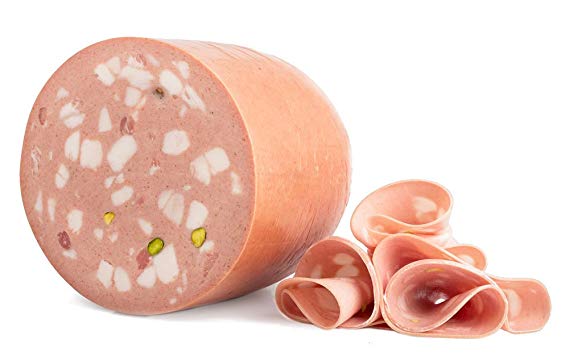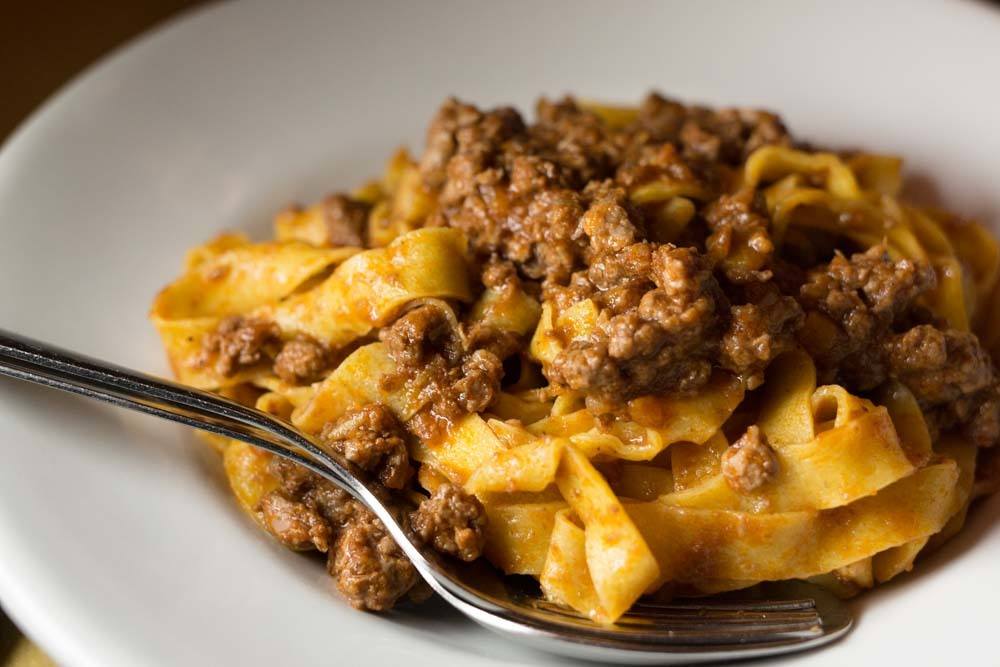Bologna, the capital city of Emilia-Romagna, is one of Italy’s best kept secrets. While many American tourists don’t even know Bologna exists, Italians consider it as a major food capital. Bologna is the birthplace of Bolognese Sauce. This area is the birthplace of Tortellini, Mortadella, Parmigiano Reggiano, and Balsamic Vinegar.
Wondering why the heck you haven’t been there? We are, too. Bologna is hardly touched by mass tourism, and offers rich history, art, architecture, and the “Motor Valley”. The “Motor Valley” is home to Ferrari and Lamborghini, Maserati, and Ducati. Most people visit Rome, Florence, and Venice and skip right over Bologna. I think Bologna deserves attention and Lonely Planet actually named Emilia Romagna as the top place to visit in Europe.
Bologna is lovingly nicknamed “La Grassa” which means “The Fat One”, and after reading this, you’ll probably understand why Bologna is truly a Food Paradise.
1. Mortadella – Don’t Call it Baloney

The pride and joy of Bologna. Mortadella is made of high quality pig fat, pistachios, peppercorns, and wine. This mixture is then stuffed into a large sausage, cooked, and cooled. Like most food products in Italy, mortadella is highly regulated. It must have an exact pork to fat ratio of 7:3. Mortadella is sliced very thin and served many different ways.
As far as finding true Italian mortadella in the US, its harder than one might think. Importing it from Italy is pretty complicated due to strict FDA regulations and requirements. If you find an authentic Italian deli, you’ll likely find mortadella there, it is a cold cut powerhouse for Italians.
2. The Legend of Tortellini

Tortellini are small pasta dumplings traditionally filled with prosciutto and parmesan cheese, both ingredients hailing from nearby towns. In Bologna, tortellini are traditionally enjoyed in a simple chicken broth. Nowadays it is common to use them with sauces from ragu to a simple butter and cheese.
The origin of tortellini is something of a legend. The tale is that there was a cross-eyed innkeeper who had the Roman goddess, Venus as a guest. One night during her stay, he accidentally saw her completely naked. Enamored by her beauty, and enchanted by her bellybutton, he decided reproduce it by making tortellini.
The oldest recipe for the tortellino (singular of tortellini) dates back to the 1300s and is actually preserved in the library of the University of Bologna.
3. SAY CHEESE!

Italy is well known for its love of cheese, from mozzarella, to parmesan, Italian cheeses are appreciated world wide. Parmigiano Reggiano is named the king of cheese and originated from Reggio Emilia, a short drive from Bologna, Italy. Parmigiano Reggiano tastes little like parmesan cheese you buy at your grocery store.
True Parmigiano Reggiano is, of course another heavily regulated food by the Italian government, they do this to ensure quality. Each wheel must meet strict criteria in every step of production and aging. Under Italian law, the name “parmigiano reggiano” and the translation “parmesan” can only refer to this protected cheese. Parmesan can exclusively be made in this region of Italy with the methods defined by the Parmigiano-Reggiano Cheese Consortium.
On our Culinary Treasures of Bologna, Venice, Michelin Stars and Exotic Cars vacation, we visit a local parmesan producer that has as great a passion for his Parmigiano-Reggiano cheese. We visit his farm that has been operating since 1868 and even get to try to milk the cows! He walks us through his place and explain the process of making the cheese. Afterwards, he treats us to some snacks and we get to taste all his cheeses- my favorite part!
4. Bolognese. Ragu? Sauce? Gravy?

hatever you want to call the red meat sauce that goes on pasta, it originated here in Bologna. The traditional name for this sauce is Bolognese. It is used to only be served on top of tagliatelle pasta and in lasagna in Bologna, but is now used on all types of pastas. Bolognese is a well known Bologna Food. Check out our recipe for Bolognese Sauce on our blog, or come visit us in Italy on our Cooking and Wine Under the Tuscan and Umbrian Sun Vacationand make it in our Villa in the countryside.
5. Fancy Balsamic Vinegar

Balsamic vinegar can range in cost from $5 to $200. You may have looked at all the balsamic vinegars in the grocery store and thought, “why would I pay $30 when I can get the same thing for $10?”. Well, I’m not going to lie to you, I have done that before. I love saving money, and I didn’t know the difference, I wasn’t even sure if I liked balsamic vinegar.
Like anything good in Italy, balsamic vinegar is heavily regulated by a balsamic vinegar certification agency. From start to finish, balsamic vinegar has to be produced in a special way. If at any time the agency tastes your vinegar and doesn’t think it represents Balsamic Vinegar well, they will take the certification away.
We learn everything about the ins and outs of how this delicious vinegar is made on a special visit to modena on our Culinary Treasures of Bologna, Venice, Michelin Stars and Exotic Cars vacation.
We visit a family-run operation where the owner, Lorenzo, shows us the love and dedication he pours into the making of the balsamic. This is a special experience, as it is not one of the Vinegar producers frequented by tourists, but a true, family operation that is opened up to us.
He lets us taste the cheap vinegars from the grocery stores, then a sample of each of his vinegars of different qualities culminating in his 25 year aged balsamic vinegar. Then we eat a lunch in his “acetaia” prepared by his family which centers around balsamic vinegar.
6. More Meat! Prosciutto!

This region has no shortage of pork products, but Prosciutto might be the most famous of them all. Unless you’ve had prosciutto in Italy, you probably haven’t actually had a really good prosciutto. The tastes and preparations of the prosciutto vary from region to region, some being more salty, some more sweet.
“Prosciutto di Parma”, as I’m sure you could have guessed by now, it is heavily regulated by the government. Prosciutto is made from the hind legs of only specific breeds of pigs from this region. It is cured with sea salt and aged. We visit Parma and learn all about the ins and outs of Parma Prosciutto production. Then we have a tasting of the famous meat on our Culinary Treasures of Bologna, Venice, Michelin Stars and Exotic Cars vacation.
7. Meat Breads

All these incredible meats deserve their own vessel to be transported into your mouth with. While much of Italy eats these meats with regular bread, white pizza, or bread sticks, Bologna has special breads for their cured meats.
Tigelle and Crescentine are breads typical of this region that are not found elsewhere in Italy. Tigelle are small bread disks that are cut in half and made into mini sandwiches. These can be stuffed with anything from pesto, to jams, to my favorite, meats and cheeses. In Bologna’s Street Food markets, you can grab a basket with a few tigelle filled with whatever your heart desires.
Crescentine are simply fried dough. Best topped with a soft cheese only found in Bologna called squacquerone (skwa-kweh-roh-neh). This is a creamy delicate cheese that is spread on top of the crescentine and topped with some prosciutto or mortadella.
Food in Bologna
In conclusion, Bologna’s Food starts and ends with meats and cheeses, which really explains both why it is called “La Grassa” – “The Fat One” and also, why Bologna is truly an Italian Food Paradise. Planted comfortably between Rome and Venice, you can easily make a pit stop in Bologna, or make a whole Cooking and Wine Vacation out of it with us.
